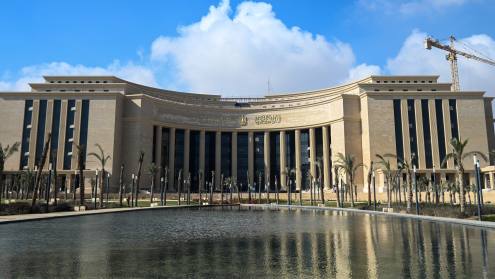April 2023 marked the seventh anniversary — and halfway mark — of Saudi Arabia’s ambitious Vision 2030 development programme, designed to modernise the country’s economy and end its reliance on oil revenues.
In an ironic twist, the milestone comes as the country enjoys its healthiest economic growth in more than a decade, benefiting from a surge in oil prices following Russia’s invasion of Ukraine.
After preaching a doctrine of privatisation and diversification for the past seven years, higher than expected hydrocarbon exports — the country’s traditional economic bedrock — saw the Saudi economy enjoy faster growth than any other G20 member in 2022.
Looking beyond the headline gross domestic product (GDP) and budget figures, however, the impact of the reforms introduced under Vision 2030 are beginning to bear fruit.
Labour market reforms, the liberalisation of the hitherto tightly controlled leisure and entertainment sectors, and a series of extravagant mega projects have all started to make their mark on the wider economy.
“Saudi Arabia’s transformation is well underway, and we are ready for take-off,” Minister of Finance Mohammed Al-Jadaan told delegates at the Financial Services Conference in the capital Riyadh in March.
Yet, while several of Vision 2030’s ambitious targets have either already been met or are poised to be exceeded ahead of time, progress in multiple key areas remains painfully slow, with a much sought after boost in inward foreign direct investment (FDI) largely yet to materialise despite the country’s best efforts.
Barrels of joy
After climbing steadily throughout 2021 as the global economy began to recover from the impact of Covid-19, oil prices surged to a 14-year high in February 2022 following Russia’s invasion of Ukraine, eventually topping an average $100 per barrel for the year for the first time since 2013.
As the world’s largest exporter of crude oil, Saudi Arabia received an extraordinary windfall for the year. The economy grew by 8.7% — its healthiest annual increase since 2011 — with the country’s budget returning to a surplus for the first time in 10 years.
With the impact of the Ukraine invasion on the sector easing towards the end of 2022, the Organization of the Petroleum Exporting Countries Plus group of major oil producers — de-facto led by Saudi Arabia and Russia — in October announced a production cut of two million barrels per day in a bid to bolster prices.
This was followed in April 2023 by a further surprise cut of 1.66 million barrels per day, led by a Saudi cut of 500,000 barrels.
we expect unemployment rates to continue declining in 2023 and in 2024
“We [have] revised our end-year price of Brent crude to $90 per barrel (previously $85) and this price effect should more than offset the impact via the change in oil output volumes, resulting in higher than previously anticipated hydrocarbon revenues and a larger surplus,” says James Swanston, a Middle East and north Africa economist at Capital Economics.
While having fallen from their highs of early 2022 — Bank of America forecasts an average price of $88 per barrel — prices remain firm enough to ensure that Saudi Arabia’s GDP will grow by 3.1% this year, the International Monetary Fund predicts, the strongest growth in the G20 outside Asia.
The production cuts in October and April received a frosty reception in the US, which had banked on looser production limits as a means of combating high inflation across the West. By contrast, prices have remained broadly stable in the country, beyond a brief spike to around 6% in mid-2021 following the trebling of value-added tax to 15% in May 2020.
After rising to an 18-month high of 3.4% in January 2023, headline inflation has since retreated to 2.7% in March, with Capital Economics forecasting a further decline to between 1.5–2% by the fourth quarter of the year, remaining around this level into 2024.
Non-oil economy stirs...
While the multiplicity of transformation schemes across the Arabian Gulf can breed a weary familiarity and generate mixed results, the scope and ambition of Vision 2030 remains unprecedented in the region in terms of the ambitious short-term targets set, and the seismic reforms introduced at the programme’s inception.
While ambitious projects remain at an early stage — including the futuristic city Neom, the $10bn Red Sea tourism development, sports and entertainment centre Qiddiya, and real estate mega project Murabba — changes such as the easing of restrictions on women, and the liberalisation of the country’s hitherto virtually non-existent leisure and entertainment sectors, have already had a significant impact.
One of the most notable achievements thus far has been female participation in the workforce, which has doubled to 36% since 2016, already exceeding the 30% target set out in Vision 2030. Significantly, much of the increase has come from the private sector, with 45% of the country’s small and medium-sized enterprises owned by women.
the private sector hasn’t had the time to adapt in the same way as in other emerging markets
Moves to stimulate Saudi employment in the private sector — previously dominated by expatriate labour — have also borne fruit. The country’s unemployment rate fell from 12% in 2016 to 8% in December, in sight of the target level of 7% set for 2030.
“The significant decline in unemployment reflects the broader growth seen in the Saudi economy,” said Jadwa Investment in a mid-April research note. “With further growth expected, we expect unemployment rates to continue declining in 2023 and in 2024.”
In March, Mr Al-Jadaan noted that non-oil revenues accounted for 35% of government expenditure in 2022, compared with around 10% at Vision 2030’s inception, and that the country’s dependence would be “a lot less” over time.
…but is yet to take off
Despite such early successes, observers query the resilience of the non-oil sector and its independence from the country’s more established sources of revenue.
“The diversification of the economy under Vision 2030 is gathering momentum, but we’re nowhere near the point where the economy is independent of oil prices,” says Tarek Fadlallah, CEO of Nomura Asset Management (Middle East). “[The] non-oil sector is still largely a derivative of the oil sector, with non-oil GDP rising and falling in line with crude prices.”
While higher employment of Saudi nationals — especially women — in the private sector is noteworthy, the private sector itself has experienced muted growth in the first half of Vision 2030.
Accounting for 40% of GDP at the start of the programme, this has subsequently grown to just 43% halfway through, falling well short of the programme’s target of 60% by 2030. This target was later revised up to 65% under the country’s National Investment Scheme (NIS) in October 2021.
With the country’s private sector (dominated by around 20 major conglomerates) judged too small and ill-equipped to develop the sector at the speed demanded by Vision 2030 and the NIS, much of the heavy lifting is happening under the auspices of the Public Investment Fund, the $600bn sovereign wealth fund chaired by the country’s de-facto ruler (and Vision 2030 architect) Prince Mohammed bin Salman.
While such funds have been used effectively in the past as a catalyst for private sector development across several markets in the past, the speed of change envisaged by Saudi’s leadership risks leaving the country’s nascent private sector behind.
“What is unusual is that they’re trying to achieve this economic transformation at a very fast pace, meaning that the private sector hasn’t had the time to adapt in the same way as in other emerging markets,” says Mr Fadlallah.
If you build it, will they come?
Halfway into Vision 2030, FDI remains perhaps the country’s greatest challenge. The government set an FDI target of 5.7% by 2030 in the original programme, later quantified at $100bn under the NIS.
Acknowledging the position of the UAE as the major centre for FDI in the region, the Saudi government went as far as to announce in February 2021 that it would only award contracts to foreign companies that have their regional headquarters in the country from 2024 onwards.
Despite such moves, FDI inflows between 2017–21 amounted to just $34.9bn, less than half the figure attracted by the UAE in the same period, according to data from the UN Conference on Trade and Development.
While the gap between the two states narrowed significantly in 2021 (thanks to the offloading by state oil firm Saudi Aramco of a 25% stake in its oil pipelines business), the country’s FDI inflows fell back to just $7.9bn in 2022.
“Despite efforts to clarify matters, there are still concerns among international investors about the investment climate in the country, regarding matters such as tax implications, ownership rights and the overall legal framework,” says Mr Fadlallah.













